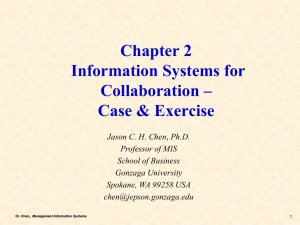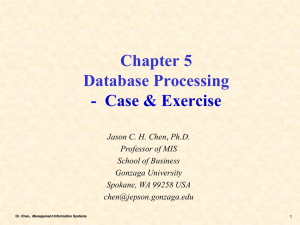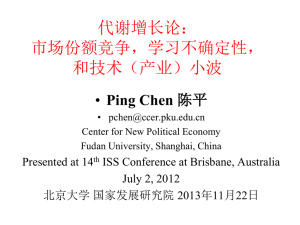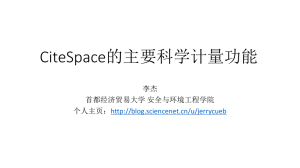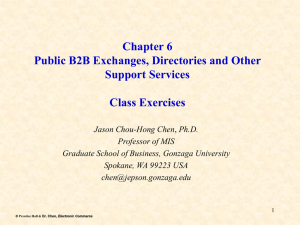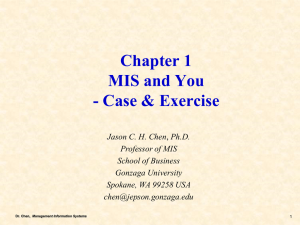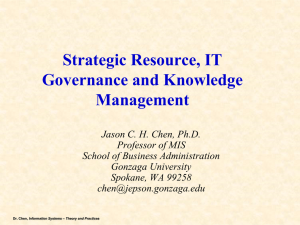Chapter 3 Effects of IT on Strategy and Competition
advertisement
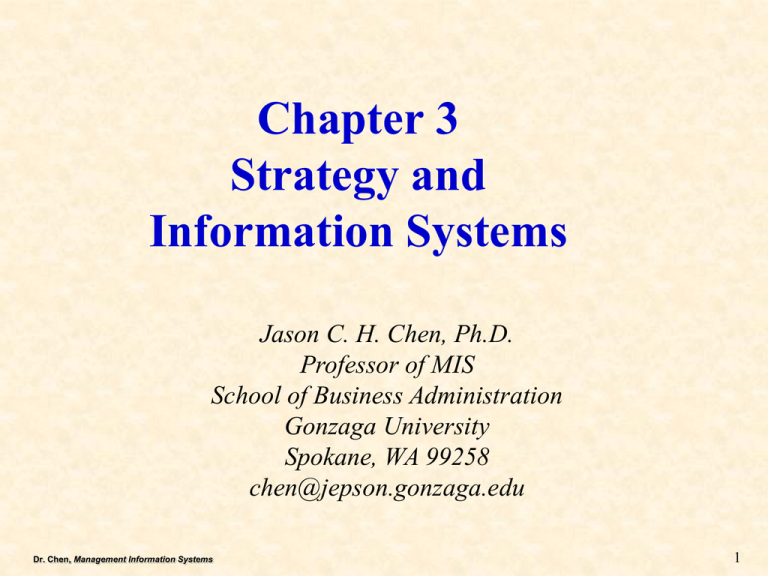
Chapter 3 Strategy and Information Systems Jason C. H. Chen, Ph.D. Professor of MIS School of Business Administration Gonzaga University Spokane, WA 99258 chen@jepson.gonzaga.edu Dr. Chen, Management Information Systems 1 Chapter Opening Scenario: “Where’s the Data?” • Buyers don’t communicate with operations when negotiating with vendors • Buyers need data to look at prices and costs of dealing with individual vendors • Need more data and people involved in making negotiating deals • What are missing and needed in this scenario? • Strategy and Information Systems Dr. Chen, Management Information Systems 2 Chapter Preview • Recall from Chapter 1 that MIS is the development and use of information systems that enable organizations to achieve their goals and objectives. In Chapter 2, you learned how information systems can help people collaborate. • This chapter focuses on how information systems support competitive strategy and how IS can create competitive advantages. As you will learn in your organizational behavior classes, a body of knowledge exists to help organizations analyze their industry, select a competitive strategy, and develop business processes. • In the first part of this chapter, we will survey that knowledge and show how to use it, via several steps, to structure information systems. • Then, in the last section, we will discuss how companies use information systems to gain a competitive advantage. Dr. Chen, Management Information Systems 3 BUSINESS VALUE & FOCUS – IS Perspective IS/E-BUSINESS •SCM •CRM •BPR •ERP Customer centric Who are the customers? Where are the customers? Their purchasing habits How to reach them? SCM: Supply Chain Mgt. CRM: Customer Relationship Mgt. BPR: Business Process Reengineering ERP: Enterprise Resource Planning Dr. Chen, Management Information Systems Demands Products Value What they need/want? How many they need/want? When they need/want? How to reach them? Business Models & Strategies 4 What is Business Model? • A business model is a set of planned activities (sometimes referred to as business processes) designed to result in a profit in a marketplace. • The business model is at the center of the business plan. • An e-commerce business model aims to use and leverage the unique qualities of the Internet and the www. Why New Models? – Profitability (making money) Source: E-Commerce: business, technology, society, Laudon and Traver, A/W Dr. Chen, Management Information Systems N 5 Study Questions Q1 How does organizational strategy determine information systems structure? Q2 Q3 Q4 Q5 Q6 Q7 Q8 What five forces determine industry structure? How does analysis of industry structure determine competitive strategy? How does competitive strategy determine value chain structure? How do business processes generate value? How does competitive strategy determine business processes and the structure of information systems? How do information systems provide competitive advantages? 2022? Dr. Chen, Management Information Systems 6 Planning is everything ... What are Two Major Outputs for an organization? develop Customers, market, competition determined by Vision Mission guide Strategy determines Goals/ Objectives create Tactic Products, Services Dr. Chen, Management Information Systems N Q1: How Does Organizational Strategy Determine Information Systems Structure? • An organization’s goals and objectives determine its competitive strategy. • Ultimately, an organization’s competitive strategy determines its information system’s – Structures – Features – Functions Fig 3-1 Organizational Strategy Determines Information Systems Dr. Chen, Management Information Systems Organizational Strategy Determines Information Systems Fig 3-1 Organizational Strategy Determines Information Systems Dr. Chen, Management Information Systems 9 Study Questions Q1 How does organizational strategy determine information systems structure? Q2 What five forces determine industry structure? Q3 How does analysis of industry structure determine competitive strategy? How does competitive strategy determine value chain structure? How do business processes generate value? How does competitive strategy determine business processes and the structure of information systems? How do information systems provide competitive advantages? 2022? Q4 Q5 Q6 Q7 Q8 Dr. Chen, Management Information Systems 10 Striving for Competitive Advantage • Firm level: Industry & Competitive Analysis – Competitive Forces Model – Competitive Strategy • Business level – Value-Chain Analysis Dr. Chen, Management Information Systems 11 Five Forces Model • Five competitive forces determine industry profitability: bargaining power of customers, threat of substitutions, bargaining power of suppliers, threat of new entrants, and rivalry among existing firms (video). • Intensity of each force determines characteristics of the industry, how profitable it is, and how sustainable that profitability will be. • Assessing an industry structure based on five questions: 1. 2. 3. 4. 5. How much bargaining power do customers have? How much of a threat do substitution products or services pose? How much bargaining power do suppliers have? How great is the threat of new competitors entering the marketplace? How great is the rivalry among existing firms? Dr. Chen, Management Information Systems 12 PORTER’S FIVE COMPETITIVE FORCES MODEL NEW MARKET ENTRANTS •Switching cost •Access to distribution channels •Economies of scale THE FIRM INDUSTRY COMPETITORS •Cost-effectiveness •Market access •Differentiation of product or service •Selection of suppler •Threat of backward integration SUPPLIERS SUBSTITUTE PRODUCTS & SERVICES Threats Bargaining power Dr. Chen, Management Information Systems Dr. Chen, The Trends of the Information Systems Technology •Redefine products and services •Improve price/performance •Buyer selection •Switching costs •Differentiation CUSTOMERS 13 N Fig 3-2 Porter’s Five Forces Model of Industry Structure Dr. Chen, Management Information Systems 14 Q/A - Enhancing your Analytic Skill Linda is in the computer repair businesses. Mark and Jill, two recent university graduates are unemployed, but are thinking of doing computer repairs at their homes. This is an example of which of the five forces? a. bargaining power of customers b. bargaining power of suppliers c. threat of new entrants d. threat of substitution e. rivalry among existing firms … and the answer is: Dr. Chen, Management Information Systems 15 Fig 3-3 Examples of Five Forces Dr. Chen, Management Information Systems 16 GearUp’s Competitive Strategy Low Cost/Focused • Do everything to keep costs down GearUp’s response the customer force is to provide the lowest prices for goods to be found, anywhere The response to the rivalry threat is to keep its customers’ attention focused on GearUp via compelling emails. • Focus within sporting goods category • Focus on buyers interested in special, short-term sales Dr. Chen, Management Information Systems Fig 3-4: Five Forces at GearUp Medium GearUp, organizations examine these five forces and determine how they intend to respond to them. That examination leads to competitive strategy. Dr. Chen, Management Information Systems 18 Study Questions Q1 Q2 How does organizational strategy determine information systems structure? What five forces determine industry structure? Q3 How does analysis of industry structure determine competitive strategy? Q4 Q5 Q6 How does competitive strategy determine value chain structure? How do business processes generate value? How does competitive strategy determine business processes and the structure of information systems? How do information systems provide competitive advantages? 2022? Q7 Q8 Dr. Chen, Management Information Systems 19 Porter’s Competitive Advantage Strategies • Cost leadership: be the cheapest • Differentiation: focus on making your product and/or service stand out for non-cost reasons • Focus: occupy narrow market niche where the products/services can stand out by virtue of their cost leadership or differentiation. Dr. Chen, Management Information Systems Porter’s Competitive Strategy Model • Firms engage in one of four competitive strategies: (video) 1. Be the cost leader across a wide industry – Wal-Mart is the lowest cost leader in the retail industry. 2. Differentiate its products across a wide industry – Apple Computer competes on how much better its computers are than PCs. 3. Be the cost leader in a focused industry segment – Southwest Airlines is the cost leader in certain portions of the airline industry. 4. Differentiate its product in a focused industry segment – Apple’s iPhone competes by being different than other cell phones. Dr. Chen, Management Information Systems 21 Figure 3 (Extra): Porter’s Generic Strategy Framework – 3 Strategies for achieving Competitive Advantage Competitive Advantage Lower Cost Position Industrywide (Broad Target) Particular Segment only (Narrow Target) Overall Cost Leadership Uniqueness Perceived by Customer Differentiation Focus N Competitive Mechanism Dr. Chen, Dr. Chen, The Trends Management of the Information Information Systems Systems Technology TM -22 Q3: How Does Analysis of Industry Structure Determine Competitive Strategy? Fig 3-4: Porter’s Four Competitive Strategies To be effective, organization goals, objectives, culture, and activities must be consistent with organization strategy. Dr. Chen, Management Information Systems 23 In-Class-Group Work Discussion Question • Using the five competitive forces model as described in this chapter to describe how (and what) IT might be used to provide a winning position for: • A global airline – Use UA as an example (Group work together) Dr. Chen, Management Information Systems 24 Use the five competitive forces model as described in this chapter to describe how information technology might be used to provide a winning position for each of these businesses • Ans: The five forces are substitutes, supplier, buyer, new entrants, and inter-industry. The question asks the student to pick a force and describe how each of these 5 types of business might use information resources to reduce the threat of that force. An example of analyzing the substitute force is given below: • Global airline-it is difficult to think of what might be a substitute threat for a global airline. Perhaps it might be a cruise ship offering "offices at sea". In that case the global airline might use information resources to offer "offices in the air". Dr. Chen, Management Information Systems 25 PORTER’S FIVE COMPETITIVE FORCES MODEL NEW MARKET ENTRANTS Internal Forces: 1.customer focus 2.communication 3.core competencies 4.complexity 5.Quality SUBSTITUTE PRODUCTS & SERVICES Threats THE FIRM INDUSTRY COMPETITORS Other forces should be considered in the e-Age: 1. Digitalization 2. Globalization 3. Deregulation •Cost-effectiveness •Market access •Differentiation of product or service SUPPLIERS Bargaining power Dr. Chen, Management Information Systems Dr. Chen, The Trends of the Information Systems Technology CUSTOMERS 26 N TM -26 Porter’s Five Forces Model and Value Chain • According to Porter, there are five competitive forces in any industry, and the attractiveness of the industry depends on the strength of each force. • Under the perspective of market structure, Porter’s competitive forces model has been broadly adopted as the underpinning for investigating the effect of information technology on the relationships between suppliers, customers, and other potential threats. Dr. Chen, Management Information Systems 27 Business Strategies and its Competitive Advantage Lower Cost Position Industry wide (Broad Target) Particular Segment only (Narrow Target) Uniqueness Perceived by Customer Cost Leadership Differentiation Cost Focus Differentiation Focus Industrial economy Knowledge-based economy Competitive Mechanism Dr. Chen, Dr. Chen, The Trends Management of the Information Information Systems Systems Technology TM -28 28 PART II Dr. Chen, Management Information Systems 29 Study Questions Q1 Q2 Q3 How does organizational strategy determine information systems structure? What five forces determine industry structure? How does analysis of industry structure determine competitive strategy? Q4 How does competitive strategy determine value chain structure? Q5 Q6 How do business processes generate value? How does competitive strategy determine business processes and the structure of information systems? How do information systems provide competitive advantages? 2022? Q7 Q8 Dr. Chen, Management Information Systems 30 Striving for Competitive Advantage • Firm level : Industry & Competitive Analysis – Competitive Forces Model – Competitive Strategy • Business level – Value-Chain Analysis Dr. Chen, Management Information Systems Q4: How Does Competitive Strategy Determine Value Chain Structure? Business Level: The Value Chain (Value) Porter’s Value Chain Model Dr. Chen, Management Information Systems 32 N Fig 3-7: Task Descriptions for Primary Activities of the Value Chain Dr. Chen, Management Information Systems Primary Activities in the Value Chain • Inbound logistics—receiving, handling raw materials and other inputs Value in parts, time required to contact vendors, maintaining relationships with vendors, ordering parts, receiving shipment, and so forth • Operations—transform or assemble materials into finished products • Outbound logistics—deliver finished products to customers • Marketing and sales—create marketing strategies and sell products or services to customers • Services—after-sale customer support Dr. Chen, Management Information Systems 34 Support Activities in the Value Chain • Contribute indirectly to production, sale, and service of product Procurement—finding vendors, setting up contractual arrangements, and negotiating prices Technology development—research and development, developing new techniques, methods, and procedures Human resources—recruiting, compensation, evaluation, and training of full-time and part-time employees performance measurement IS Example: ____________________________ Firm infrastructure—general management, finance, accounting, legal, and government affairs Dr. Chen, Management Information Systems 35 Value Chain • Competitive strategy implemented by creating value Value—amount of money a customer is willing to pay for a resource, product, or service Margin—difference between value an activity generates and cost of activity Value chain—a network of value-creating activities • Primary activities • Support activities Rather than automating or improving existing functional systems, Porter contends companies should create new, more efficient business processes that integrate the activities of the entire value chain. Dr. Chen, Management Information Systems 36 Value Chain in Order Management An Existing Product Support Activities Administrative and Other Indirect Value Added Primary Activities Production Sales and Manufacturing Distribution/ Service Logistics D.B. Dr. Chen, Management Information Systems Accounting N Value Chain in Order Management A New Product Support Activities Administrative and Other Indirect Value Added Primary Activities Production Sales Finance and Manufacturing D.B. Dr. Chen, Management Information Systems Distribution/ Marketing Logistics Service Fig 3-6: Bicycle Maker’s Value Chain Dr. Chen, Management Information Systems Support Activities in the Value Chain Support Activity Description Technology R & D, New Techniques, Methods, Procedures Procurement Raw Materials Human Resources Training, Recruiting, Compensation Firm Infrastructure General Management, Finance, Accounting, Legal, Government Affairs Dr. Chen, Management Information Systems Value Chain Linkages • Linkages are the interactions across the value activities. Ex: Manufacturing systems use linkages to reduce inventory costs, sales forecasts to plan production; production plan to determine raw materials needs; material needs to schedule purchases. End result is just-intime inventory, which reduces inventory sizes and costs. • Business process design Organizations should not automate or improve existing functional systems. Rather, they should create new, more efficient business processes that integrate activities of all departments involved in a value chain. Dr. Chen, Management Information Systems 41 Study Questions Q1 Q4 How does organizational strategy determine information systems structure? What five forces determine industry structure? How does analysis of industry structure determine competitive strategy? How does competitive strategy determine value chain structure? Q5 How do business processes generate value? Q6 How does competitive strategy determine business processes and the structure of information systems? How do information systems provide competitive advantages? 2022? Q2 Q3 Q7 Q8 Dr. Chen, Management Information Systems 42 How Do Business Processes Generate Value? • Business process—network of activities that generate value by transforming inputs into outputs. • Cost of a business process is cost of inputs plus the cost of activities. • Margin of the business process equals the value of the outputs minus the cost (margin = value – cost) • Activity transforms input resources into output resources. • Resources flow between or among activities. • Facilities store resources; some facilities, such as inventories, store physical items. Dr. Chen, Management Information Systems 43 How Do Business Processes Generate Value? • Each company has many business processes which are networks of activities that generate value by transforming inputs into outputs. • You determine the cost of each business process by adding the cost of inputs plus the cost of activities used in the process. • You determine the margin of each business process by subtracting the cost of the activity from the value of the output. Dr. Chen, Management Information Systems 3-44 An Alternate Process for Bicycle Manufacturer Fig 3-8 Three Examples of Business Processes Dr. Chen, Management Information Systems 45 Compare Three Business Processes For Bicycle Manufacturer • Notice that activities get data resources from databases and put data into databases • Business processes vary in cost and effectiveness. In fact, the streamlining of business processes to increase margin (add value, reduce costs, or both) is key to competitive advantage. • Example of using a linkage across business processes to improve process margin: Querying both databases allows purchasing department to make decisions on raw materials quantities and customer demand. By using this data, purchasing can reduce size of raw materials inventory, reducing production costs and thus adding margin to the value chain. Dr. Chen, Management Information Systems 46 Fig 3-9: Improved Material Ordering Process Dr. Chen, Management Information Systems 47 Business Process Summary • Key to a company’s competitive advantage is to increase the margin of its products by adding value, reducing costs, or both. • Business process redesign helps a business streamline its activities in order to increase its margins. • Most difficult part of process redesign is associated with employee resistance. Dr. Chen, Management Information Systems 48 Study Questions Q1 Q2 Q3 Q4 Q5 How does organizational strategy determine information systems structure? What five forces determine industry structure? How does analysis of industry structure determine competitive strategy? How does competitive strategy determine value chain structure? How do business processes generate value? Q6 How does competitive strategy determine business processes and the structure of information systems? Q7 Q8 How do information systems provide competitive advantages? 2022? Dr. Chen, Management Information Systems 49 Q6: How Does Competitive Strategy Determine Business Processes and the Structure of Information Systems? Fig 3-10: Operations Value Chains for Bicycle Rental Companies Dr. Chen, Management Information Systems Fig 3-10: Operations Value Chains for Bicycle Rental Companies Dr. Chen, Management Information Systems 51 Fig 3-10: Operations Value Chains for Bicycle Rental Companies Dr. Chen, Management Information Systems 52 High-Service Business Bike Rental [1] [2] [3] [4] Fig 3-11 Business Process & Information System (DB process) for Bike Rental Dr. Chen, Management Information Systems 53 Bottom Line • Each business must first analyze its industry structure and choose a competitive strategy. Will it be a low-cost provider or differentiate its products from competitors? • Then it must design its business processes to span valuegenerating activities. • Those processes determine scope and requirements of each organization’s information systems. Dr. Chen, Management Information Systems Study Questions Q1 Q2 Q3 Q4 Q5 Q6 How does organizational strategy determine information systems structure? What five forces determine industry structure? How does analysis of industry structure determine competitive strategy? How does competitive strategy determine value chain structure? How do business processes generate value? How does competitive strategy determine business processes and the structure of information systems? Q7 How do information systems provide competitive advantages? Q8 2022? Dr. Chen, Management Information Systems 55 Q7: How Do Information Systems Provide Competitive Advantages? • Product Implementation – 1. Create a new product or service – 2. Enhance products or services – 3. Differentiate products or services • System Implementation – – – – – 4. Lock in customers and buyers 5. Lock in suppliers 6. Raise barriers to market entry 7. Establish alliance 8. Reduce costs Figure 3-12: Principles of Competitive Advantage Dr. Chen, Management Information Systems 56 • There are two ways businesses can respond to the five competitive forces. (video) – 1) They can gain a competitive advantage via their products and services by • creating new products or services, • Enhancing existing products or services, • Differentiating their products and services from those of their competitors by cost and quality – 2) They can gain a competitive advantage by developing superior business processes with Information Systems. Products/ Services Dr. Chen, Management Information Systems N 57 Fig 3-13: Information Systems Create Competitive Advantages as Product or Support (Two Roles 58 Dr. Chen, Management Information Systems Gaining Competitive Advantage by Using Business Processes 1. Lock in customers Create high switching costs 2. Lock in suppliers Make it easy to connect to and work with your organization 3. Create entry barriers Make it difficult and expensive for new competition 4. Create better business processes to establish alliances Organizations—establish standards, promote product awareness and needs, develop market size, reduce purchasing costs, and provide other benefits 5. Reduce costs Enables reducing prices and/or to increasing profitability. Increased profitability means more cash to fund further infrastructure development and greater competitive 59 advantage. Dr. Chen, Management Information Systems How Does an Actual Company Use IS to Create Competitive Advantages? • ABC, Inc, an actual company, created a competitive advantage in shipping industry by: Superior customer service Making it easy for customers to business with by minimizing data entry: • Drop-down lists, automatic fill-ins, contact lists for customers • Minimizing data-entry errors • Following slide shows some of the Web pages of ABC’s information system. Dr. Chen, Management Information Systems 60 Fig 3-14: ABC, Inc Web Page to Select recipient from customer records Dr. Chen, Management Information Systems 61 Fig 3-15: ABC, Inc Web Page to Select Contact from Customer Records Dr. Chen, Management Information Systems 62 Fig 3-16: ABC, Inc Web Page to Specify Email Notification Dr. Chen, Management Information Systems 63 Fig 3-17: ABC, Inc Web Page to Print a Shipping Labels Dr. Chen, Management Information Systems 64 How Does This System Create a Competitive Advantage? • ABC’s information system helps the company create a competitive advantage: Enhances its existing services - making it easy for the customer to use its system, and reducing errors. Differentiates its products/services from its competitors who don’t have a similar service to provide to customers. Provides new services for customers that competitors don’t provide (i.e., innovation) Locks in customers into its system based on the benefits they receive from it. Raises barriers to market entry Increases profit margins by decreasing costs and decreasing errors Dr. Chen, Management Information Systems 65 Study Questions Q1 Q7 How does organizational strategy determine information systems structure? What five forces determine industry structure? How does analysis of industry structure determine competitive strategy? How does competitive strategy determine value chain structure? How do business processes generate value? How does competitive strategy determine business processes and the structure of information systems? How do information systems provide competitive advantages? Q8 2022? Q2 Q3 Q4 Q5 Q6 Dr. Chen, Management Information Systems 66 Q8 2022? • Unlikely GearUp will exist Like most startups, it will go bankrupt or Purchased by a large retailer, or It will merge with other personal shopping sites to form a supersite, or It grows into a bigger company and becomes a supersite of its own. • New opportunities for IT-based organizations Reduce medical costs by supporting governmental functions, like Medicare and related programs Web-based services to track medical bills, Medicare and supplemental insurance payments, track unpaid bills Dr. Chen, Management Information Systems Essential Value Propositions for a Successful Company • • • Business Model ________ Core ________ Competency Execution ________ – Set corporate goals and get executive sponsorship for the initiative 68 Dr. Chen, Management Information Systems Enhanced Model of “Built To Last”: Continuity and Change in Visionary Companies Strategic Competitive Advantages and creating values Preserve •Core Values •Core Purpose Change •Culture & Operating Practices •Specific Goals and Strategies •Processes •Safety •Quality Care •Efficiency •Effectiveness •Innovation Management Dr. Chen, Management Information Systems IT (tangible, strategic mechanism) 69 • END OF CHAPTER 3 Dr. Chen, Management Information Systems 70

